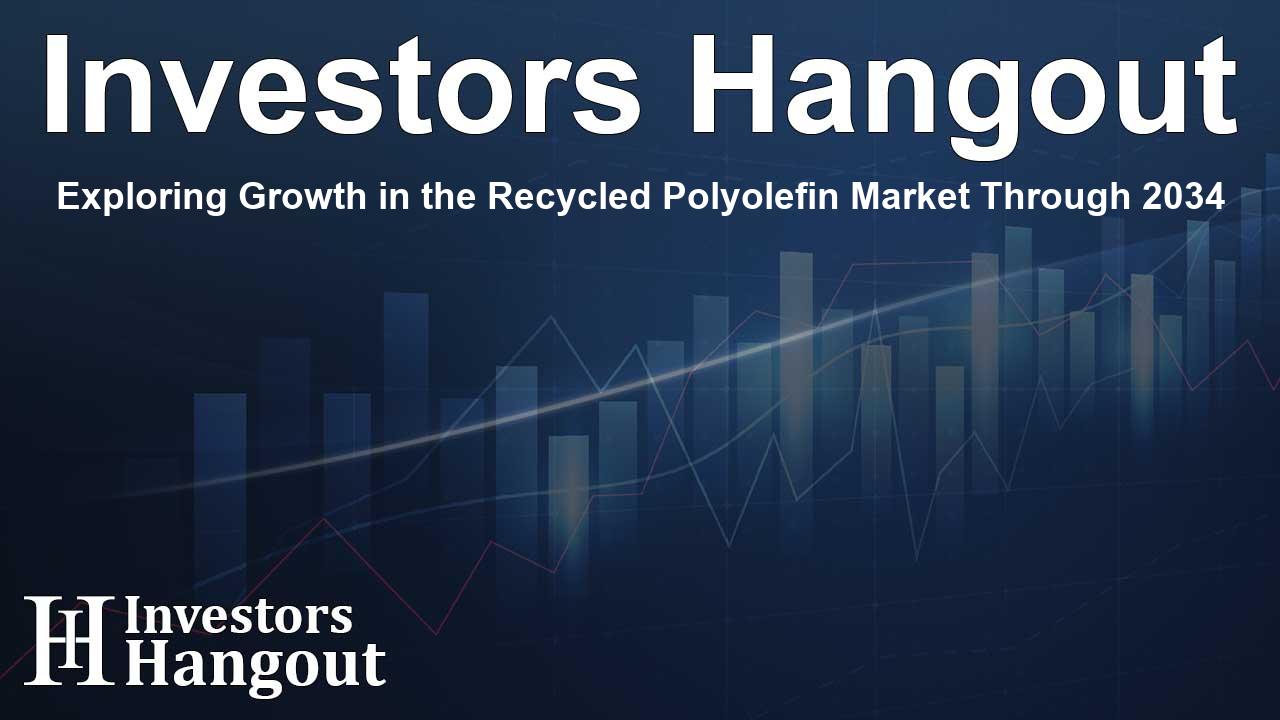Exploring Growth in the Recycled Polyolefin Market Through 2034

Overview of the Recycled Polyolefin Market
The recycled polyolefin market is experiencing remarkable growth, currently valued at approximately USD 66.67 billion, and projected to exceed USD 144.2 billion by 2034. This growth reflects a compound annual growth rate (CAGR) of 8.95% during the forecast period. Key factors driving this market expansion include a shift towards sustainable packaging solutions, advancements in recycling technologies, and a surge in demand for recyclable materials across various sectors.
Driving Factors Behind Market Expansion
Focus on Sustainability
The increasing emphasis on sustainability is propelling businesses to incorporate recycled materials into their production processes. This shift is evident in various industries, particularly in packaging and automotive sectors, where lightweight and environmentally-friendly materials are in high demand. As consumers become more environmentally conscious, brands are under pressure to adopt sustainable practices.
Technological Advancements
Innovations in recycling technologies are enhancing the quality and efficiency of recycled polyolefins. Advanced chemical recycling methods are now capable of producing high-quality output, meeting stringent safety standards for uses in packaging and automotive applications. Enhanced sorting systems and collection methodologies are also improving the overall recycling process, ensuring a more reliable supply of high-grade recycled materials.
Market Segmentation Analysis
Product Type
Among the various product types, Low-Density Polyethylene (LDPE) stands out as the leader in the recycled polyolefin market due to its widespread application in packaging films. This material's flexibility and cost-effectiveness make it a favorite among manufacturers looking to implement sustainable practices.
Source of Materials
Plastic bottles remain the dominant source in recycled polyolefin production, attributed to their widespread consumption and efficient collection systems. The ease of sorting and processing plastic bottles provides a reliable stream of high-quality recycled raw materials, critical for meeting both consumer demand and regulatory standards.
Regional Insights
Asia Pacific's Market Dominance
The Asia Pacific region dominates the global recycled polyolefin market, expected to grow from USD 30.49 billion in 2025 to USD 66.03 billion by 2034. The region's industrial development, government incentives, and rising demand from sectors such as automotive and construction are integral to this growth. Significant investments in recycling infrastructure, particularly in countries like India and China, support the overall sustainability goals of the region.
Europe's Rapid Growth
Europe is anticipated to see the fastest growth in the recycled polyolefin market, driven by stringent environmental regulations and increasing consumer awareness. Legislative measures aimed at reducing single-use plastics and promoting recycled content in packaging are accelerating the shift towards circular economy models. Countries within Europe are also making significant strides in both mechanical and chemical recycling technologies, further supporting market growth.
Challenges to Market Growth
Quality Concerns
Despite the positive trends, challenges such as variable quality of recycled materials present significant barriers. Contamination during collection, as well as physical degradation, often results in inconsistencies that can affect the usability of recycled polyolefins in some high-end applications.
Infrastructure Limitations
The lack of effective waste collection and sorting infrastructure, especially in developing regions, hampers the growth potential of the recycled polyolefin market. Governments are being urged to invest in better waste management systems to enhance the availability of clean polymer waste for recycling.
Future Outlook and Investment Opportunities
The future of the recycled polyolefin market looks promising, fueled by increasing demand for sustainable packaging. Companies like Unilever and PepsiCo are leading the charge in adopting more post-consumer recycled content in their products. As regulations tighten and consumer awareness grows, the market is expected to continue flourishing, presenting numerous opportunities for investments in recycling technologies and sustainable practices.
Frequently Asked Questions
What is the projected growth rate of the recycled polyolefin market?
The market is expected to grow at a CAGR of 8.95% from 2025 to 2034.
Which regions are leading in the recycled polyolefin market?
The Asia Pacific region dominates, with Europe expected to experience the fastest growth.
What are the key products in the recycled polyolefin market?
Low-Density Polyethylene (LDPE) and Plastic Bottles are among the top contributors in the market.
What are the main challenges facing the market?
Variable quality of recycled materials and inadequate collection infrastructure are significant challenges.
How is technology impacting the recycled polyolefin market?
Technological advancements in recycling processes are improving quality and efficiency, enabling higher purity outputs.
About The Author
Contact Dylan Bailey privately here. Or send an email with ATTN: Dylan Bailey as the subject to contact@investorshangout.com.
About Investors Hangout
Investors Hangout is a leading online stock forum for financial discussion and learning, offering a wide range of free tools and resources. It draws in traders of all levels, who exchange market knowledge, investigate trading tactics, and keep an eye on industry developments in real time. Featuring financial articles, stock message boards, quotes, charts, company profiles, and live news updates. Through cooperative learning and a wealth of informational resources, it helps users from novices creating their first portfolios to experts honing their techniques. Join Investors Hangout today: https://investorshangout.com/
The content of this article is based on factual, publicly available information and does not represent legal, financial, or investment advice. Investors Hangout does not offer financial advice, and the author is not a licensed financial advisor. Consult a qualified advisor before making any financial or investment decisions based on this article. This article should not be considered advice to purchase, sell, or hold any securities or other investments. If any of the material provided here is inaccurate, please contact us for corrections.
